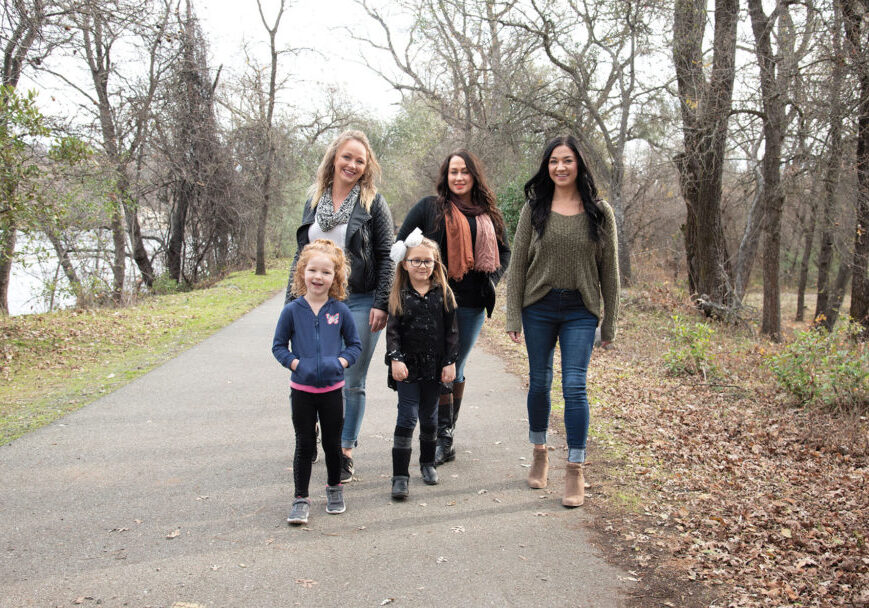As I approach yet another bright red traffic light, I can feel my heart begin to pound and irritability surge through my veins. These traffic lights are always getting in my way—slowing me down and preventing me from crossing anything off my ever-growing list of errands. My response is to pull out my phone for those two- to three-minute increments of red light “free” time. I can respond to a few emails or text messages, but this habit only leads to more stress since I’m constantly looking up to make sure I don’t miss the light turning green because I definitely don’t want to get honked at by the (similarly) impatient driver behind me. Sound familiar?
Many of us spend our days rushing around irritated by things that seem to waste our time, but this is only zapping more cortisone through our bodies and exacerbating stress. So, what if we started viewing these moments as golden opportunities for mindfulness throughout our day, whether we are stuck in the school carpool line, sitting in a doctor’s office, standing in a long line at a store or working on mundane chores?
The magic of mindfulness
Mindfulness is the act of focusing on the moment at hand in a non-judgmental way. It gives us an awareness of our thoughts, feelings, bodily sensations and surrounding environment and allows us to quiet the endless distracting chatter of our mind so we can focus on “the now.” We can experience mindfulness through a formal meditation practice or informal ways like deep breathing exercises and paying attention to physical sensations.
According to the Greater Good Science Center at University of California, Berkeley, thousands of studies show that mindfulness improves our physical and mental health because it relaxes us and reduces stress and anxiety. One study, for example, published in the journal “Psychiatry Research: Neuroimaging,” suggests that meditating for just 30 minutes a day for eight weeks can increase the density of gray matter in parts of our brain involved with stress, memory and empathy. These brain changes show that mindful meditation can improve our ability to regulate emotions and control our stress levels.
How to replace boredom with mindfulness
According to Elisha Goldstein, Ph.D., co-founder of The Center for Mindful Living in Los Angeles and author of several books including Uncovering Happiness, boredom, like the boredom felt at a red light, is an emotion intertwined with anxiety. “We have an automatic reaction to boredom,” Dr. Goldstein says. “We tell ourselves that we should be doing something more valuable with our time or that we are missing out on something better. We try to avoid it, so we partake in activities to fill the space, such as stress eating, technology and other poor habits.”
To be more mindful throughout our day, Dr. Goldstein recommends that we shift our view of dull tasks from a nuisance or impediment and start engaging with them with a sense of curiosity. “By learning to befriend boredom, we can consciously choose what we want to do in that moment and no longer be enslaved by negative emotions. Mindfulness can help transform our perspective during instances that we may otherwise consider to be boring. Being mindful and still can be filled with curiosity, daydreaming, awe and even bliss.”
We have endless opportunities to introduce mindful curiosity throughout our daily routine. Here are some ways you can get started.
Mindfulness in the car
Parents tend to turn into taxi drivers for our kids. While trying to get from one activity to another, we hit all sorts of annoying obstacles. We can learn how to make our time in the car more mindful with a few tricks. Dr. Ronald Siegel, author and professor of psychology at Harvard Medical School, suggests drivers practice a taillight meditation while waiting behind other cars. Simply focus on the colors and shapes of the taillights in front of you while remaining relaxed and alert. Let your body soften and your eyes lose focus for a few moments while stopped. Another idea when stopped is to really open your eyes and look around to savor nature’s beauty. Take a moment to notice the luscious trees, colorful flowers and ever-changing clouds in the sky.
Mindful kitchen chores
I don’t know about you, but I feel like I spend half of my life in the kitchen. Next time you find yourself dreading these repetitive duties, try to turn them into a mini-meditation session by engaging your senses. When you are doing the dishes, think about how the soap feels and smells, see the colors reflected off the bubbles, hear the water and recall the flavors of your meal. When you are setting or clearing the table ask yourself these questions:
- How heavy does each cup, plate, utensil and napkin feel in your hand?
- Are the objects smooth or rough, hard or soft?
- What sounds do you hear when you place each object on the table?
- What colors and patterns do you see?
- What do the plates smell like as you clear them off the table?
You can also take a step back from your parenting role and imagine you are a child experiencing the task for the first time. “Engaging with a ‘beginner’s mind’ causes our brain to light up and helps us feel excited and energetic,” says Dr. Goldstein.
Putting your children to bed mindfully
The bedtime routine can feel like the worse possible part of our day. Dr. Goldstein recalled how he would get so irritated during his sons’ bedtime because he couldn’t stop thinking about how he needed to get back to the pile of work sitting on his desk. Yet, his kids were coming up with every excuse possible to delay bedtime, which would make him even more stressed. Instead of blowing up at them, he tapped into mindfulness to recognize that, yes, this is a challenging moment. “It helped me to actually name the experience by telling myself this is really hard. That act of being mindful in that stressful moment helped diminish my stress and anger.”
Kate Hanley, personal development coach and author of Stress Less, suggests parents look forward to their children’s bedtime as a chance to practice mindfulness. “When you snuggle with your kids, you can count your breaths. If your children insist that you stay in the room while they fall asleep, instead of getting anxious about everything you could be doing, use that time to meditate until they fall asleep and you can quietly sneak out.”
Our kids are like clever little spies—watching our every move. By turning irritating parts of our day into a more relaxing, introspective time, we are not only helping ourselves but also passing along an invaluable tool to our children so they can live happier, healthier lives with a little mindfulness magic.
Fun Mindfulness Exercises to Share with Your Kids
Mindful eating
Instead of shoving food into our mouths, mindful eating can help us to savor and truly enjoy what we are eating. Ask your children to use their five senses to describe the food on their plates by color, texture, smell, taste and sounds as they chew. While on the go, bring along some snacks to practice being mindful. Trail mix is a must-have since it is non-perishable and contains multiple items to taste like granola, nuts, seeds, raisins, dried cranberries, yogurt drops and chocolate pieces.
Mindful breathing
Teaching children to breathe mindfully is the cornerstone of stress reduction. We can pass along this important tool to them using some fun, playful approaches:
- Bubbles: Have them practice breathing by taking in a deep breath before blowing some bubbles. Once they have mastered this activity, you can always ask them to simply visualize blowing the bubbles.
- Heart Hands: Create a heart shape with your hands. As you breathe in, expand your hands to a heart shape. As you breathe out, collapse your hands into two fists side by side.
- Birthday Candle: Ask children to take a deep breath in and then push the breath out as if they are blowing out a birthday candle. The more stress they are experiencing, the more birthday candles they will need to blow out.
Mindful coloring
In the last few years, coloring books for stress reduction have become all the rage. Creative activities like coloring have been scientifically proven to reduce stress levels because we become so focused on what we are doing when we reach a state of “flow” that we forget what is going on around us. Your children can use any type of coloring book, but mandalas are very popular in the mindfulness world. What a fun activity to enjoy together!
Posted in: Health & Nutrition
Comment Policy: All viewpoints are welcome, but comments should remain relevant. Personal attacks, profanity, and aggressive behavior are not allowed. No spam, advertising, or promoting of products/services. Please, only use your real name and limit the amount of links submitted in your comment.
You Might Also Like...

Pack Pain: Backpack Safety for Back to School
Kids everywhere will head back to class this fall with their own unique sense of fashion on display. Whether students sport a message tee, cargo shorts or a school uniform, […]

The Troubled Tummy: Deciphering Your Child’s Chronic Digestive Distress
The dinner scene is dishearteningly familiar. Your 8-year-old daughter takes a couple bites of spaghetti, then starts poking at the food on her plate. “Eat up!” you say brightly, hoping […]

Developmental Optometry And Vision Therapy – What It Is And How It Can Help
Have you felt helpless about your child’s school performance? You are not alone. Did you know vision therapy can help? On the Children’s Vision Information Network website, a parent explains […]

The Subtlety of Heart Disease in Women
Heart Disease is Often Subtle in Women Know the Signs, What to Do, and How to Prevent It The leading cause of death among women in the United States is […]




